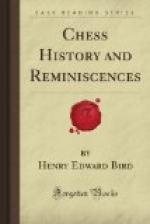conjectured merely, that when the dice had to be dispensed
with, as contrary to the law and the religion of the
Hindus and when such laws were vigorously enforced,
it then became a test of pure skill only, and was
probably more generally engaged in by two competitors
than four; but, it appears reasonable, when we recollect
the oft translated story of Nala, and the evident
fascination of the dice to the Hindus, to suppose
that the dice formed far too an important element
in the Chaturanga to be so easily surrendered; and
it is not at all improbable that the prohibition and
suppression of the dice destroyed much of its popularity
and that the game became much less practiced and ceased
to be regarded with a degree of estimation sufficiently
high to make it national in character, or deemed worthy
of the kind of record likely to be handed down to
prosperity. Notwithstanding that the moves of
Kings, Rooks and Knights in the Chaturanga were the
same as they are now, the absence of a Queen, (which
even in the two-handed chess was long only represented
by a piece with a single square move) and the limited
power of the Bishops and Pawns, must have made the
Chaturanga a dull affair compared with present chess
as improved towards the close of the Fifteenth century;
and it is not so very remarkable that it should have
occurred to Tamerlane to desire some extension of
its principles, even with our present charming and,
as some consider, perfect game, we find that during
the 17th and 18th centuries, up to Philidor’s
time not a good recorded game or page of connected
chess history is to be found and we may cease to wonder
so much at the absence of record for four or three
thousand years or more, for a game so inferior to
ours. Were the Chaturanga now to be revived without
the dice it would probably not prove very popular.
Authorities say “But, unquestionably, the favourite
game among the ancient Hindus, was that of chess;
a knowledge of which in those primitive times formed
one of the requisite accomplishments of a hero, just
as skill in chess was considered among us in the palmy
days of Chivalry.”
What this game was is not explained; beyond the description
of the oblong die of four sides, used to determine
which piece had to move in the Chaturanga; we have
no information how a game of interest could be made
with dice alone, as is not easy to understand.
------
We have no means of ascertaining, says Forbes the
exact era at which the Chaturanga passed into the
Shatranj, or in other words at what period as the
Muhammadans view it, the Hindus invented the latter
form of the game. The earlier writers of Arabia
and Persia do not agree on the point, some of them
placing it as early as the time of Alexander the Great
and others as late as that of Naushurawan. Even
the poet Firdausi, the very best authority among them
though he devotes a very long and a very romantic
episode to the occasion of the invention of the Shatranj,
is quite silent as to the exact period; all that he
lets us know on that point is that it took place in
the reign of a certain prince who ruled over northern
India and whose name was Gau, the son of Jamhur.




